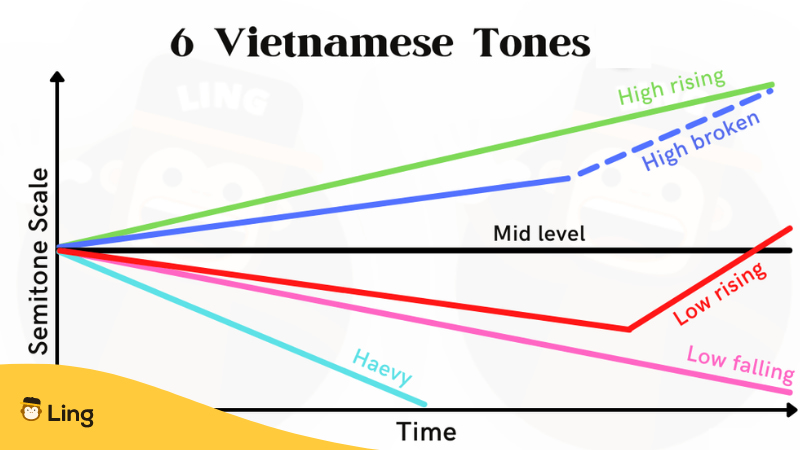Vietnamese is a tonal language. It means that you need to learn how to pronounce Vietnamese tones correctly as the tones play an important role in the meaning of a Vietnamese word or phrase.
There are six (6) tones in the Vietnamese language with five (5) tone marks that we will have you covered today:
- Mid-Level Tone (Thanh Ngang): doesn’t have a tone mark
- Low Falling Tone (Thanh Huyền): the tone mark for the low falling tone is ” ” (dấu huyền)
- High Rising Tone (Thanh Sắc): the tone mark for this tone is “/” (dấu sắc)
- Low Rising Tone (Thanh Hỏi): the low rising tone has a tone mark that looks like a question mark without a dot called “dấu hỏi”
- High Broken Tone (Thanh Ngã): the tone mark for the high broken tone is “~”
- Heavy Tone (Thanh Nặng): the heavy tone has the tone mark as a dot “.” we add it under the vowels
What Are The Six Vietnamese Tones?
Different tonal languages have different numbers of tones. For example, Thai has five tones while Cantonese has nine tones. There are six tones in Vietnamese that you need to learn and master when you learn Vietnamese.

1. Mid-Level Tone (Thanh Ngang)
The mid-level tone in Vietnamese is called thanh ngang. To pronounce the mid-level tone, keep your voice flat and even. Don’t raise your voice nor make it fall. Thanh ngang will sound similar to “sing” in an affirmative sentence in English.
The mid-level tone doesn’t have a tone mark.
Below are some words that have the mid-level tone or flat tone:
- Ca – to sing [Speechword voice=”Vietnamese Male” isinline]Ca[/Speechword]
- Ma – a ghost
- Ba – dad, three
- La – to scream out loud, to shout out loud
- Hoa – a flower
2. Low Falling Tone (Thanh Huyền)
The low falling tone or “thanh huyền” is pronounced when you lower your voice. It sounds similar to “Uhm” in English when you agree with someone about something.
The tone mark for the low falling tone is ” ” (dấu huyền) which looks like it is in the word “huyền” or in the following examples:
3. High Rising Tone (Thanh Sắc)
Thanh Sắc is the Vietnamese name of the high rising tone in Vietnamese. You need to raise your voice up quickly to create this tone. It sounds similar to “What???” in English.
The tone mark for this tone is “/” (dấu sắc) as you can see in the word “sắc”. Many words have this Vietnamese tone mark, as follows:
- Cá – a fish
- Má – cheek, mom (in Southern Vietnamese dialect)
- Bá – mother’s older sister (in Northern Vietnamese accent)
- Lá – a leaf
- Hoá – chemistry
4. Low Rising Tone (Thanh Hỏi)
“Thanh Hỏi” or “Low Rising Tone” is created when you first low down your voice as in thanh huyền, then raise up your voice at the end of the word. It will sound similar to “really?” but a bit faster.
The low rising tone has the tone mark called dấu hỏi and the tone mark looks like a question mark without a dot and is put on the top of a word like it is in the word hỏi.
Below are more examples of the Vietnamese tones with words including”dấu hỏi”:
5. High Broken Tone (Thanh Ngã)
This might be the most difficult tone in Vietnamese which has challenged a lot of Vietnamese learners.
The way to pronounce Thanh Ngã is to raise your voice as you do when you pronounce Thanh Sắc (high-rising tone) but at the end of the sound, you suddenly stop it. It also sounds similar to when you say something at a high tone but someone punches your belly so your voice is broken. That sounds interesting huh?
The tone mark for the high broken tone is “~”. Let’s try to pronounce the following words:
- Mã – a horse (Chinese-Vietnamese word)
- Bã – the dried fiber you get after chewing and drinking all the juice from sugarcane, or any plants or fruit.
- Lã – plain (water)
Kindly note that this tone is also difficult for native Vietnamese speakers from the central and the south of Vietnam.
6. Heavy Tone (Thanh Nặng)
You might be able to guess the way this tone should be pronounced. Just say a word with a really heavy and low voice.
Thanh Nặng has the tone mark as a dot “.” but under the vowels. For examples:
Why Are Vietnamese Tones Important To Learn?
If you notice in the examples given earlier, with different tone marks, the words change their meaning completely. As mentioned, Vietnamese is a tonal language, and these six tones are crucial in Vietnamese pronunciation.
You can learn vocabulary slowly but try your best to pronounce the Vietnamese words or phrases clearly and accurately. Otherwise, native speakers will find it difficult to understand you.
For example, dưa – dừa – dứa are three different fruits: watermelon – coconut – pineapple. If you want to order pineapple juice, but you don’t know how to pronounce the word “dứa” correctly, you may end up drinking coconut or watermelon juice.
Tips To Speak Vietnamese Tones Correctly
The pronunciation of the tone marks in Vietnamese doesn’t change upon consonants or vowels as the Thai tones do. The Vietnamese tones remain the same way to pronounce every word. It means that when you see a Vietnamese tone mark, you know which tone you need to pronounce the word.
In English, you have intonation, and your voice will rise or fall differently when you ask a question, and when you say an affirmative sentence. However, this doesn’t work the same way in Vietnamese. You can change the pitch of your voice for a question, but you still need to pronounce the six tones in the correct way.

Let’s Practice The Vietnamese Six Tones
Try to pronounce the words or sentences below before listening to the audio.
- Chào anh! – Hello
- Phụ nữ – a woman
- Đàn ông – a man
- Nhật Bản – Japan
- Trung Quốc – China
- Mỹ – USA
- Tôi là một người phụ nữ – I am a woman
- Bạn là một người đàn ông – You are a man
- Tôi đến từ Mỹ – I come from the USA
Learn More Vietnamese With The Ling App
How many phrases or sentences have you pronounced accurately? Test your speaking skills more with the Ling app and master the Vietnamese tones right today!
In the Ling app, you can open the speaking game in each unit, and then speak a phrase or a sentence given in the game. After that, the app evaluates and shows you how well you did and also points out which parts you should improve. You can download the Ling app on the Play Store or App Store to try it, and let us know if you like it!















